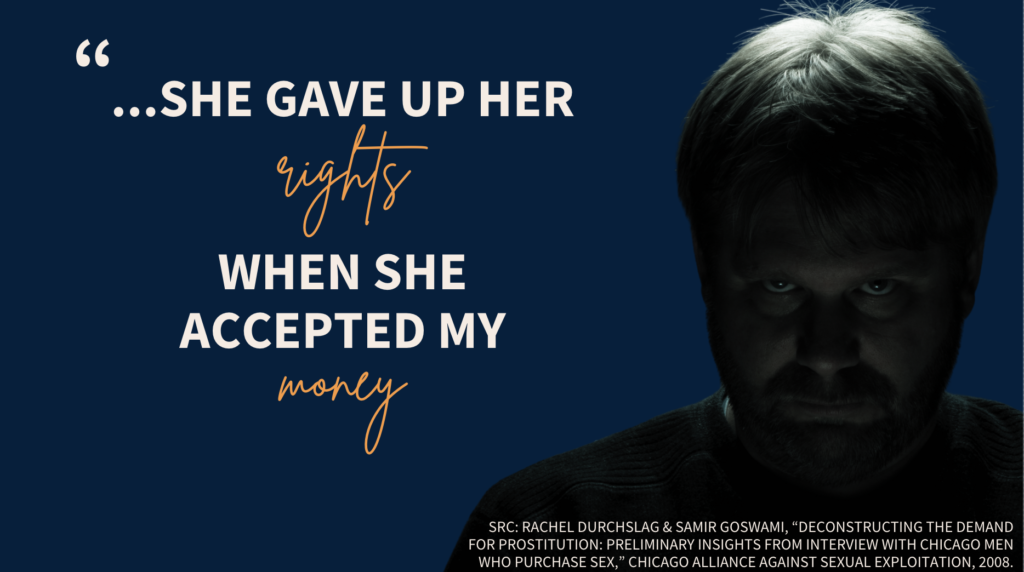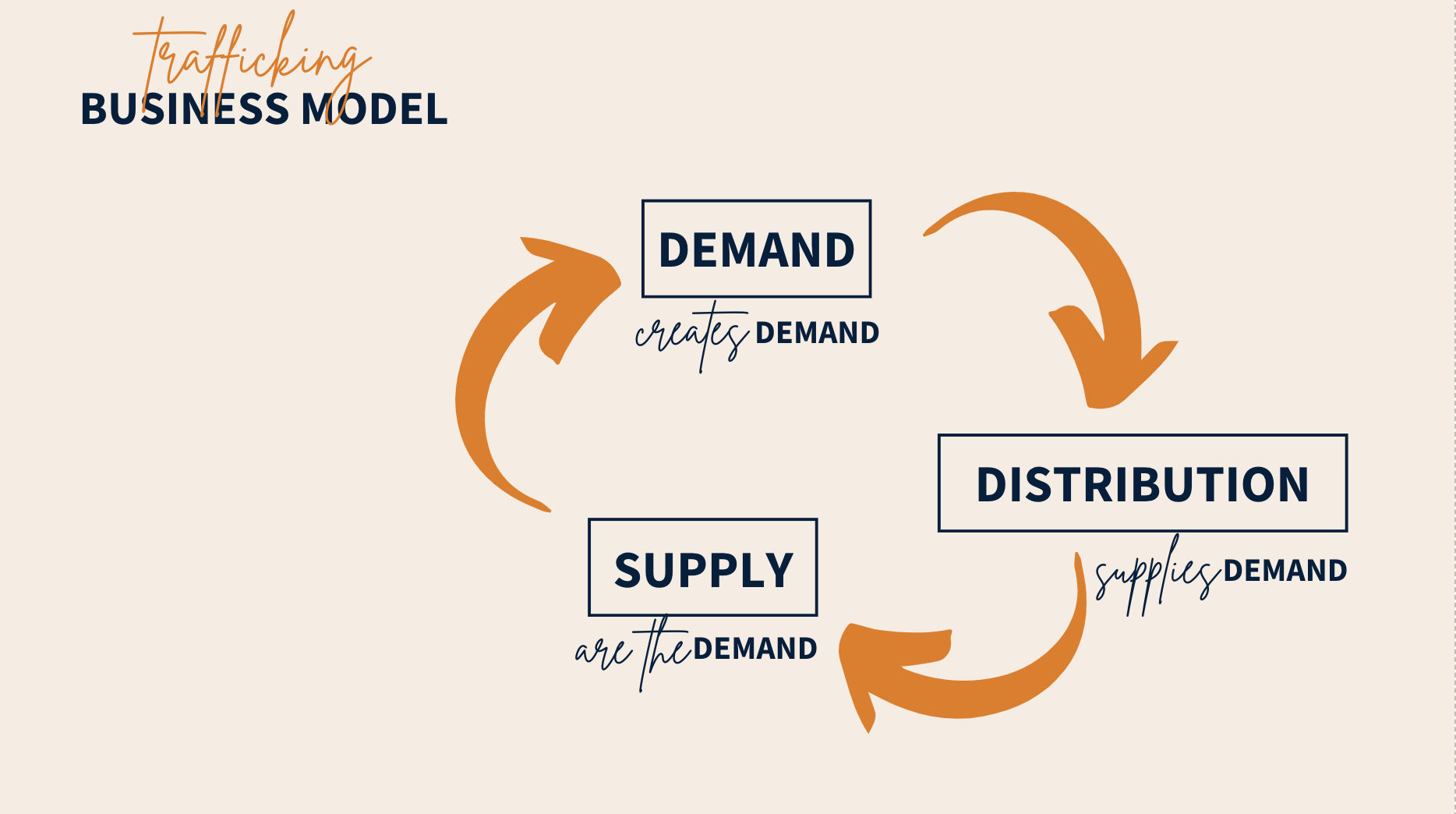Human trafficking is an illegal, organized criminal business that thrives on the exploitation of people for beneficial means, like profit. It is a lucrative “business” because it is perceived as low-risk and high-profit.
Human trafficking follows the simple business model of supply and demand, but is adapted to look a bit more like this: Buyers create the demand, traffickers are the opportunists supplying it and tragically, the victims become the exploited commodity.
No matter how you look at it, beneath the surface lies a disturbing truth – all parties involved, from buyers to traffickers to victims, are trapped in a cycle of unhealed trauma.
Buyers Seeking Power through Exploitation

Many buyers who fuel the demand for human trafficking are driven by a desperate attempt to fulfill unmet emotional needs. These needs, often stemming from childhood abuse or neglect, can manifest as a desire for power, control, or a warped sense of intimacy. Individuals who experienced a lack of control or safety in their formative years may seek to exert dominance over another human being in adulthood. This power dynamic, however, is a twisted illusion. Trafficking fosters a cycle of abuse, not genuine connection. Similarly, buyers with unmet intimacy needs might seek connection through exploitation, a behavior rooted in a perverted understanding of love and affection.
In addition, addiction can be another layer of this complex issue. Those struggling with addiction may turn to buying victims as a way to numb emotional pain or escape difficult feelings. However, this behavior ultimately reinforces the addiction and perpetuates the underlying trauma. The act of buying a victim becomes a temporary fix, not a solution, reinforcing these negative coping mechanisms. Instead of confronting the root of their pain, they become further entangled in a web of trauma, perpetuating the cycle for themselves and their victims.
By dehumanizing their victims, buyers attempt to lessen the cognitive dissonance they experience. Dissociation, a psychological defense mechanism, allows them to disconnect from the reality of their actions. This detachment serves as a shield against the guilt and shame that might otherwise arise from inflicting suffering on another human being. Ultimately, these destructive coping mechanisms only serve to deepen the buyer’s own trauma, leaving them emotionally isolated and unable to heal.
Traffickers: A Twisted Reflection of Trauma

Traffickers, often the ruthless suppliers of this terrible cycle, are driven by a deep-seated desire for power and control. The power and control they exert over their victims can be a distorted reflection of their own past experiences.
Many traffickers have endured violence, abuse, or extreme poverty, leaving them feeling powerless and desperate. This trauma can manifest into a warped sense of empowerment. By controlling and exploiting others, they reclaim a semblance of power they felt they once lacked. The cycle of abuse becomes tragically self-perpetuating. Having potentially been victims themselves, they are unable to break free and instead inflict the same trauma on others.
Their own early experiences can contribute to their lack of empathy. The coping mechanism of being emotionally detached which may have served them in the past allows them to manipulate and exploit their victims with a cold-blooded heart.
The control tactics they employ might mirror those used by their own abusers, creating a twisted reality where inflicting pain becomes a means of asserting dominance. But this “power” is only an illusion, as true power doesn’t lie in domination, but in healing from the wounds of the past.
The Devastating Impact on Victims
The human cost of human trafficking is immeasurable and devastating. Victims endure unimaginable psychological trauma that can leave lasting scars. Post-traumatic stress disorder (PTSD) and complex trauma are a common consequence, with victims reliving the horrors of their experience through flashbacks, nightmares and panic attacks. Depression, anxiety, and dissociation are also common, leaving victims struggling to cope with the overwhelming emotions and memories, which can also lead to substance use and abuse and a load of other physical health issues.
The impact of trafficking is often compounded by pre-existing vulnerabilities. Poverty, lack of opportunity, or a history of abuse (to name a few) can make individuals easier targets for traffickers. These vulnerabilities create a desperate situation where false promises of a better life can seem like the only escape.
Once they’re entrapped, the coercion deepens the psychological impact, leaving victims feeling trapped and isolated. Trauma bonding, or Stockholm Syndrome, can develop between the victims and their traffickers. This occurs when victims, fueled by a mixture of fear and isolation, begin to rely on their traffickers for basic needs, leading to a malformed sense of loyalty and affection.
The power dynamics and manipulation tactics employed by traffickers create a confusing and terrifying situation for victims. It’s crucial to remember that victims are never to blame for their circumstances. They are trapped in a web of trauma, exploited by those who seek to profit from their suffering. And above all, they are survivors, who no matter what, deserve our empathy and support.
Beyond Blame
Human trafficking thrives in the shadows cast by unhealed trauma. This trauma trap is a vicious cycle where the pain of one perpetuates the pain of another. We do not condone the exploitive acts perpetrators enact on their victims, but it does require we take a deeper look and acknowledge the root causes that fuel this cycle.
By understanding the trauma that may underlie the actions of all involved, we can begin to dismantle the system that enables it. This doesn’t excuse anyone’s actions, but allows us to develop a more comprehensive approach to combating human trafficking. There is hope for breaking free from this “trauma trap.”
The Power of Healing + Prevention
Healing is paramount for all involved and requires a multifaceted approach. Trauma-informed therapy and support groups can provide victims with the tools to rebuild their lives. While the path for traffickers and buyers is complex, there is potential for them to confront their own trauma and the root causes of their destructive behavior through intervention programs and therapy. It’s not an impossible journey to break the chains of the past and choose to carry on with a different path.
However, healing alone cannot dismantle the system that enables trafficking. Prevention is key. By addressing root causes – the breakdown of the family, poverty, lack of education and employment opportunities, and social inequalities – we can empower individuals and create a society that is less susceptible to exploitation. Investing in our youth, parents and creating strong support systems that promote strengthening families and building healthier communities are critical for proactive prevention efforts.
Human trafficking is a symptom of a festering wound on the body of our society. It exposes the raw nerve of unhealed trauma. To eradicate this evil, we must confront it on both fronts: healing the wounds of the past and preventing new ones from forming.
Support organizations that empower individuals and survivors, advocate for policies that address root causes and promote awareness about the underlying trauma behind human trafficking. Only by working together with a shared understanding can we break the cycle and build a future free from this modern-day slavery.

